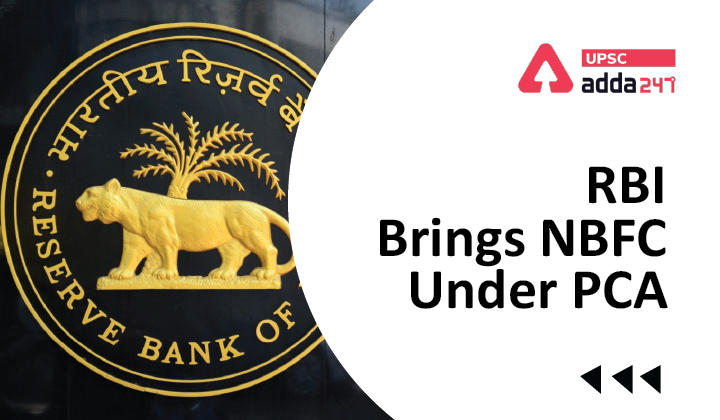Table of Contents
Prompt Corrective Action: Relevance
- GS 3: Indian Economy and issues relating to planning, mobilization, of resources, growth, development and employment.
Prompt Corrective Action framework RBI: Context
- Reserve Bank of India (RBI) has recently decided to bring Non-Banking Finance Companies (NBFCs) under the ambit of the Prompt Corrective Action (PCA) framework.
Prompt Corrective Action framework for NBFCs: Key points
- The PCA framework for NBFCs will come into effect from October 1, 2022, based on the financial position of NBFCs on or after March 31, 2022.
- Applicability: It will be applicable for all deposit-taking NBFCs — excluding government NBFCs, primary dealers and housing finance companies — and other non-deposit taking NBFCs in the middle, upper and top layers.
- PCA framework is already available for banks.
- The PCA framework does not preclude the Reserve Bank from taking any other action as it deems fit at any time in addition to the corrective actions prescribed in the framework.

Prompt Corrective Action framework for NBFCs: Why needed?
- NBFCs have been growing in size and have substantial inter-connectedness with other segments of the financial system. So, a PCA framework for NBFCs would strengthen the supervisory tools applicable to NBFCs.
- Moreover, four big finance firms — IL&FS, DHFL, SREI and Reliance Capital — which collected public funds through fixed deposits and non-convertible debentures collapsed in the last three years despite the tight monitoring in the financial sector.
- They collectively owe over Rs 1 lakh crore to investors.
- It has necessitated the current RBI move to bring NBFCs under the PCA framework.
Prompt Corrective Action framework for NBFCs: Objectives
- To enable supervisory intervention at appropriate time and so that the supervised entity could initiate and implement remedial measures in a timely manner, so as to restore its financial health.
- The PCA framework is also intended to act as a tool for effective market discipline.
PCA framework for NBFCs: Risk Thresholds
There are three risk thresholds in the PCA framework for NBFCs.
| Thresholds | Parameters | Implications |
| Threshold 1
|
If the net non-performing assets is between 6-9%.
If the capital adequacy ratio falls 300 basis points from the current level of 15-12%.
|
NBFCs will be restricted on dividend distribution.
Promoters will be asked to infuse capital and reduce leverage. The RBI will also restrict issuance of guarantees or taking other contingent liabilities on behalf of group companies, in case of core investment companies.
|
| Threshold 2
|
If the net non-performing assets is between 9-12%
If the capital adequacy ratio falls 300-600 bps from 12-9%.
|
NBFC will be prohibited from opening branches
|
| Threshold 3
|
If the net non-performing assets is more than 12%.
If the capital adequacy ratio falls by 600 bps from 9%.
|
All capital expenditure will be stopped, other than for technological upgradation.
|
Also Read:
| World Trade Organisation (WTO) | India Loses WTO Dispute over Sugar Subsidies | National Leprosy Eradication Programme | Coal Controller Organisation |
| Green Day Ahead Market | World Energy Outlook 2021 | 44th Constitutional Amendment Act | One Commodity One Exchange’ Policy |
| India International Science Festival (IISF) | Gaganyaan Space Mission | The Upcoming Crisis in Indian Federalism | Protests In Cuba And The Cuban Crisis |




 TSPSC Group 1 Question Paper 2024, Downl...
TSPSC Group 1 Question Paper 2024, Downl...
 TSPSC Group 1 Answer key 2024 Out, Downl...
TSPSC Group 1 Answer key 2024 Out, Downl...
 UPSC Prelims 2024 Question Paper, Downlo...
UPSC Prelims 2024 Question Paper, Downlo...




